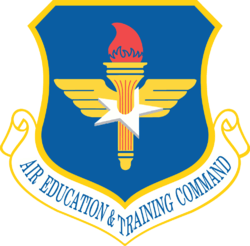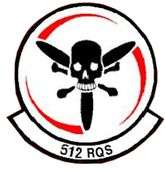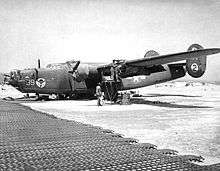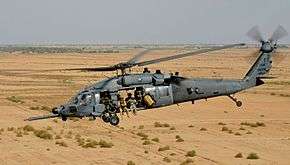512th Rescue Squadron
512th Rescue Squadron
 | |
|---|---|
|
HH-60 Pave Hawk as flown by the squadron | |
| Active | 1942–1946; 1947–1948; 1949–1951; 1951–1965; 1994–present |
| Country |
|
| Branch |
|
| Role | Search and Rescue Training |
| Part of | Air Education and Training Command |
| Garrison/HQ | Kirtland Air Force Base |
| Engagements |
Mediterranean Theater of Operations Korean war |
| Decorations |
Distinguished Unit Citation Air Force Outstanding Unit Award |
| Insignia | |
| 512th Rescue Squadron emblem (approved 13 April 1995)[1] |
 |
| 512th Bombardment Squadron emblem (approved 6 January 1944)[1] |
 |

The 512th Rescue Squadron is part of the 58th Special Operations Wing based at Kirtland Air Force Base, New Mexico. It operates UH-1N Twin Huey and HH-60G Pave Hawk aircraft conducting search and rescue missions.
Mission
Provide Mission-Ready H-1 and H-60 Crewmembers to Helicopter Units Worldwide
History
World War II
Established in the Middle East during late 1942 to aid British Forces during the Western Desert Campaign. Initially equipped with obsolete B-17C/D Flying Fortresses transferred from Tenth Air Force. Replaced with B-24 Liberators flown from Florida via South America; over to then across Central Africa then north to Egypt in early 1943. Became part of United States Middle East Air Forces (USMEAF), later Ninth Air Force.
Operating from bases in British Palestine, Egypt, Libya and Tunisia, attacked shipping in the Mediterranean and harbor installations in Libya, Tunisia, Sicily, and Italy to cut enemy supply lines to North Africa. Struck airdromes, marshalling yards, and other objectives in Sicily and Italy after the fall of Tunisia in May 1943. Reassigned to Fifteenth Air Force in late 1943, and moved to southern Italy. Squadron flew long range strategic bombardment missions to targets in Italy, France, Germany, Czechoslovakia, Austria, Hungary, and the Balkans to bomb factories, marshalling yards, oil refineries, oil storage facilities, airdromes, bridges, harbors, and other objectives.
After the German Capitulation in May 1945, returned to the United States; was re-equipped with B-29 Superfortress bombers and trained under Second Air Force for deployment to the Pacific Theater. However with the Japanese Capitulation in August, the training ended and most personnel demobilized by the end of October. Remained in active status but not fully manned or equipped, and subsequently inactivated in early 1946 due to budget restrictions. The squadron was not fully manned or equipped between 10 November 1945 and 26 March 1946 and was unmanned from, 23 May 1947 – 20 September 1948.[1][2]
Korean War
Based in Japan at the beginning of the Korean War, the 512 RS, flying RB/WB-29s, performed daily strategic weather reconnaissance missions over the combat zone, conducted shipping surveillance and visual reconnaissance, and accomplished electronic countermeasures reconnaissance until 20 February 1951. In the early days of the conflict, the squadron also dropped leaflets. Initially unarmed, and later only lightly armed with two .50-caliber machine guns in the tail turret, the WB-29s flew daily missions over enemy-held territory. During 27 June through 27 December 1950, the squadron flew over 200 combat missions, making over 5,000 vitally needed weather observations. These missions were exceptionally hazardous because of extremely varying weather conditions and exposure to attack over enemy territory. One of the squadron's WB-29s served as an aerial command post and weather station, giving on-the-spot weather data and directions to incoming bombers on the first B-29 strike (13 July 1950) against North Korean installations. On this and several later such missions, the WB-29 carried Major General Emmett O'Donnell, Jr., USAF, Commander, FEAF Bomber Command. The 512 RS was replaced by the 56th Strategic Reconnaissance Squadron in February 1951.
Cold War
Reactivated in May 1951. Practiced electronic countermeasures with B-29 aircraft from c. 1952 until conversion to B-47 Stratojet jet medium bombers in 1954. Between 1954 and 1965, the 513 Bombardment Squadron flew a long series of simulated combat bombardment missions to maintain readiness as a unit of the Strategic Air Command, testing electronic warfare devices and radar techniques, using B-47 and EB-47 aircraft. Inactivated in 1965 with the retirement of the B-47.
Modern era
Currently the 512th participates in special operations contingencies, exercises, and humanitarian rescue helicopter training.[2]
Lineage
- Constituted as the 512th Bombardment Squadron (Heavy) on 19 October 1942
- Activated on 31 October 1942
- Redesignated 512th Bombardment Squadron, Heavy on 3 May 1944
- Redesignated 512th Bombardment Squadron, Very Heavy on 23 May 1945
- Inactivated on 26 Mar 1946
- Redesignated 512th Reconnaissance Squadron, Very Long-Range, Weather on 6 May 1947
- Activated on 23 May 1947
- Inactivated on 20 September 1948
- Activated on 13 February 1949
- Inactivated on 20 February 1951
- Redesignated 512th Bombardment Squadron, Medium on 25 May 1951
- Activated on 1 June 1951
- Inactivated on 15 Mar 1965
- Redesignated 512th Special Operations Squadron on 25 March 1994
- Activated on 1 April 1994
- Redesignated 512th Rescue Squadron on 6 October 2000[1]
Assignments
- 376th Bombardment Group, 31 Oct 1942
- 468th Bombardment Group, 10 Nov 1945 – 26 Mar 1946
- 376th Reconnaissance Group, 23 May 1947
- Air Weather Service, 16 Sep 1947
- 308th Reconnaissance Group, 14 Oct 1946 – 20 Sep 1948; 1 Feb 1949
- 2143d Air Weather Wing, 14 Nov 1949 – 20 Feb 1951
- 376th Bombardment Group, 1 Jun 1951
- 376th Bombardment Wing, 16 Jun 1952 – 15 Mar 1965
- 58th Special Operations Wing, 1 Apr 1994 – present
Stations
Aircraft Operated
- B-17 Flying Fortress (1942)
- B-24 Liberator (1942–1945)
- B-29 Superfortress (1945, 1949–1954)
- RB/WB-29 (1949–1951)
- C-47 Skytrain (1949–1950)
- C-54 Skymaster (1950–1951)
- B-47 Stratojet (1954–1961)
- EB-47 Stratojet (1961–1965)
- UH-1N Twin Huey (1994–present) Callsign SAVE
- HH-60 Pave Hawk (1994–present) Callsign SKULL
Operations
References
- Notes
- 1 2 3 4 Robertson, Patsy (October 9, 2009). "Factsheet 512 Rescue Squadron (AETC)". Air Force Historical Research Agency. Retrieved November 30, 2016.
- 1 2 "Factsheet 512th Rescue Squadron". Air Education and Training Command. December 31, 2013. Archived from the original on December 17, 2014. Retrieved November 30, 2016.
Bibliography
![]() This article incorporates public domain material from the Air Force Historical Research Agency website http://www.afhra.af.mil/.
This article incorporates public domain material from the Air Force Historical Research Agency website http://www.afhra.af.mil/.
- Futrell, Robert F. (1983). The United States Air Forces in Korea 1950-1953. Washington, DC: Office of Air Force History. ISBN 0-912799-71-4. Part 1 Part 2 Part 3 Part 4
- Maurer, Maurer, ed. (1983) [1961]. Air Force Combat Units of World War II (PDF) (reprint ed.). Washington, DC: Office of Air Force History. ISBN 0-912799-02-1. LCCN 61060979.
- Maurer, Maurer, ed. (1982) [1969]. Combat Squadrons of the Air Force, World War II (PDF) (reprint ed.). Washington, DC: Office of Air Force History. ISBN 0-405-12194-6. LCCN 70605402. OCLC 72556.
- Ravenstein, Charles A. (1984). Air Force Combat Wings, Lineage & Honors Histories 1947-1977 (PDF). Washington, DC: Office of Air Force History. ISBN 0-912799-12-9.



